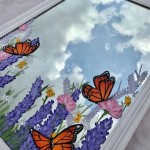How To Chalk Paint A Mirror Frame: A Comprehensive Guide
Chalk paint has gained considerable popularity in recent years for its ease of use and ability to transform furniture and decorative items with a vintage or rustic aesthetic. Its excellent adhesion properties mean minimal surface preparation is required, making it an ideal choice for updating a mirror frame. This article provides a detailed, step-by-step guide on how to chalk paint a mirror frame, ensuring a professional and long-lasting finish.
1. Preparation: Setting the Stage for Success
Proper preparation is crucial for achieving a flawless and durable chalk paint finish. This stage involves gathering the necessary materials, protecting the surrounding areas, and preparing the mirror frame itself. Neglecting this step can lead to adhesion issues, uneven coverage, and an unsatisfactory final result.
Gathering Supplies: The following materials are essential for chalk painting a mirror frame:
- Chalk paint in your desired color
- Chalk paint wax (clear or tinted)
- Wax brush (specifically designed for chalk paint wax)
- Chalk paint brush (a round or angled brush is recommended)
- Painter's tape
- Drop cloth or protective sheeting
- Clean cloths (lint-free)
- Fine-grit sandpaper (220 grit or higher)
- Mild cleaning solution (dish soap and water)
- Screwdriver (if removing the mirror from the frame)
- Optional: Primer (if the frame is particularly glossy or has a dark finish)
Protecting the Work Area: Chalk paint can be messy, so it's imperative to protect the surrounding surfaces. Lay down a drop cloth or protective sheeting to cover the floor and any nearby furniture. This will prevent accidental paint splatters and stains.
Preparing the Mirror Frame: The frame needs to be clean and slightly roughened to ensure optimal paint adhesion. Begin by cleaning the frame with a mild cleaning solution to remove any dust, dirt, grease, or fingerprints. Use a clean, damp cloth to wipe the frame, and then dry it thoroughly with another clean cloth. If the frame has any loose paint or flaking finish, gently sand it down with fine-grit sandpaper until the surface is smooth. Pay particular attention to edges and corners. If the existing finish is particularly glossy or dark, consider applying a thin coat of primer to provide a better base for the chalk paint. Allow the primer to dry completely according to the manufacturer's instructions.
Taping off the Mirror: Carefully apply painter's tape to protect the mirror glass. Ensure the tape is firmly adhered to the frame, creating a tight seal to prevent paint from seeping underneath. Overlap the tape slightly onto the frame to ensure full coverage and avoid any gaps. Ensure the mirror is completely covered to avoid paint transferring on it.
2. Chalk Painting: Applying the Paint and Achieving the Desired Look
The chalk painting process involves applying thin, even coats of paint to the mirror frame, allowing sufficient drying time between coats. The number of coats required will depend on the color of the paint, the color of the frame, and the desired level of coverage.
Applying the First Coat: Dip the chalk paint brush into the paint, removing any excess by tapping it lightly against the edge of the can. Apply the paint to the frame in thin, even strokes, following the grain of the wood if applicable. Avoid applying the paint too thickly, as this can lead to drips and uneven drying. Work in small sections, overlapping each stroke slightly to ensure complete coverage. Chalk paint typically dries quickly, but it's important to allow ample drying time before applying the second coat. Refer to the manufacturer's instructions for specific drying times, typically around 30 minutes to 1 hour.
Applying Subsequent Coats: Once the first coat is completely dry, inspect the frame for any areas that require additional coverage. Apply a second coat of chalk paint in the same manner as the first, using thin, even strokes. If a third coat is necessary, repeat the process. Allow each coat to dry thoroughly before proceeding to the next step. Remember that multiple thin coats are preferable to one thick coat, as they will result in a smoother, more durable finish.
Achieving Different Looks: Chalk paint is versatile and can be used to create a variety of different looks. For a smooth, modern finish, apply the paint in smooth, even strokes, ensuring minimal texture. For a more rustic or distressed look, use a dry brushing technique, applying the paint sparingly and allowing some of the original finish to show through. Alternatively, you can sand the edges and corners of the frame after the paint has dried to reveal the underlying wood or finish, creating a distressed effect.
Addressing Imperfections: If you notice any drips, runs, or uneven patches during the painting process, address them immediately. Use a clean, damp cloth to wipe away any drips or runs before they dry. If the paint has already dried, gently sand the affected area with fine-grit sandpaper until it is smooth. Apply another thin coat of paint to the area to blend it in with the surrounding finish. Remember that minor imperfections can often be hidden or minimized during the waxing process.
3. Waxing: Sealing and Protecting the Finish
Waxing is an essential step in chalk painting, as it seals and protects the paint, enhancing its durability and preventing it from chipping or scratching. Chalk paint is porous and requires a protective topcoat to prevent staining and water damage.
Applying the Wax: Apply a small amount of chalk paint wax to the wax brush. Work the wax into the bristles of the brush to ensure even distribution. Apply the wax to the frame in thin, even layers, working in small sections. Use a circular motion to massage the wax into the paint, ensuring it penetrates all the nooks and crannies. Remove any excess wax with a clean, lint-free cloth. The goal is to apply a thin, even layer of wax, not a thick, gloppy coat.
Buffing the Wax: After the wax has been applied, allow it to sit for approximately 30 minutes to an hour. This allows the wax to partially harden and bond with the paint. Buff the waxed surface with a clean, lint-free cloth, using a circular motion. Buffing removes any excess wax and creates a smooth, lustrous finish. The more you buff, the greater the sheen will be. You can adjust the level of sheen to your personal preference by varying the amount of buffing.
Optional: Applying a Second Coat of Wax: For added protection and durability, consider applying a second coat of wax. Follow the same steps as for the first coat, applying a thin, even layer of wax, allowing it to sit for 30 minutes to an hour, and then buffing it with a clean cloth. A second coat of wax will enhance the sheen and provide a more durable finish, particularly for high-traffic areas.
Tinted Wax (Optional): If desired, tinted wax can be used to add depth and dimension to the chalk paint finish. Apply the tinted wax in the same manner as clear wax, but be extra careful to remove any excess, as tinted wax can easily stain the paint. Experiment with different colors of tinted wax to create unique and customized effects. For example, dark wax can be used to accentuate the details of the frame and create an aged or antique look.
4. Finishing Touches: Completing the Project
Once the waxing process is complete, it's time to add the finishing touches and admire your newly chalk-painted mirror frame. This involves removing the painter's tape, cleaning the mirror, and reassembling the mirror if it was disassembled earlier.
Removing the Painter's Tape: Carefully remove the painter's tape from the mirror, pulling it away from the frame at a 45-degree angle. This will help prevent any paint from chipping or peeling. If any paint has seeped under the tape, use a craft knife to carefully score along the edge of the tape before removing it.
Cleaning the Mirror: Clean the mirror glass with a glass cleaner to remove any fingerprints, smudges, or paint smudges. Use a clean, lint-free cloth to wipe the glass dry. Ensure the mirror is sparkling clean to showcase the newly painted frame.
Reassembling the Mirror: If you removed the mirror from the frame earlier, carefully reassemble it. Secure the mirror to the frame using the original screws or fasteners. Ensure the mirror is properly aligned and securely attached to the frame.
Curing Time: Although chalk paint and wax dry relatively quickly, it takes several days for the finish to fully cure and harden. During this time, avoid placing heavy objects on the frame or exposing it to excessive moisture. Allow the finish to fully cure before cleaning it with harsh chemicals or abrasive cleaners.
By following these detailed steps, you can successfully chalk paint a mirror frame, transforming it into a beautiful and unique piece of decor. The versatility of chalk paint allows you to customize the finish to suit your personal style and create a truly one-of-a-kind piece.

Chalk Paint Mirror Centsational Style

Chalk Paint And Antiquing A Frame Mirror Diy Painting Frames

Painting A Mirror Frame Easy Yet Stunning Ideas Girl In The Garage

Chalk Painting An Antique Mirror Frame Tutorial Rise And Renovate

How To Chalk Paint A Picture Frame Grillo Designs

Distressed Farmhouse Style Mirror Frame With Chalk Paint An Easy Home Decor Diy Tutorial In 5 Steps A Flourishing Place

Ornate Mirror Makeover

Diy Chalk Painting With Dark Wax Hallstrom Home

Tutorial Create The Weathered Wood Look With Paint Transform A Mirror

12 Techniques To Painting Antique Mirrors Hallstrom Home








